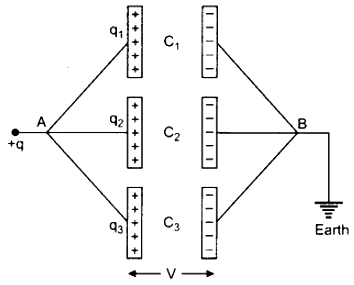Parallel Combination of Capacitors:
This combination is adopted when greater capacity is required from smaller capacities. In this combination one plate of each capacitor is connected at one junction and other plates on other junction as shown in following diagram. The junctions are A and B. Suppose +q charge is given to this combination. This charge is distributed on capacitors according to their capacities.

∴ q1 + q2 + q3 …………….. (1)
Since all the capacitors are joined between A and E therefore the potential difference of all the capacitor will be same.
∴ V = \(\frac{q_{1}}{C_{1}}=\frac{q_{1}}{C_{2}}=\frac{q_{3}}{C_{3}}\)
∴ q1 = C1V, q2 = C2V, q3 = C3V
If C be the equivalent capacity combination,
then q = CV
Therefore from equation (1),
CV = C1V + C2V + C3V
Similarly n capacitors can be joining in parallel
C = C1 + C2 + C4 +… + Cn